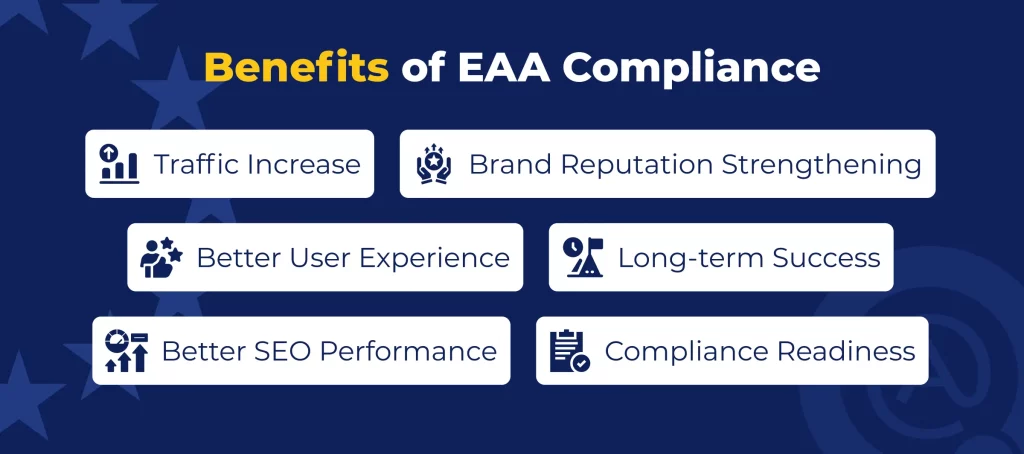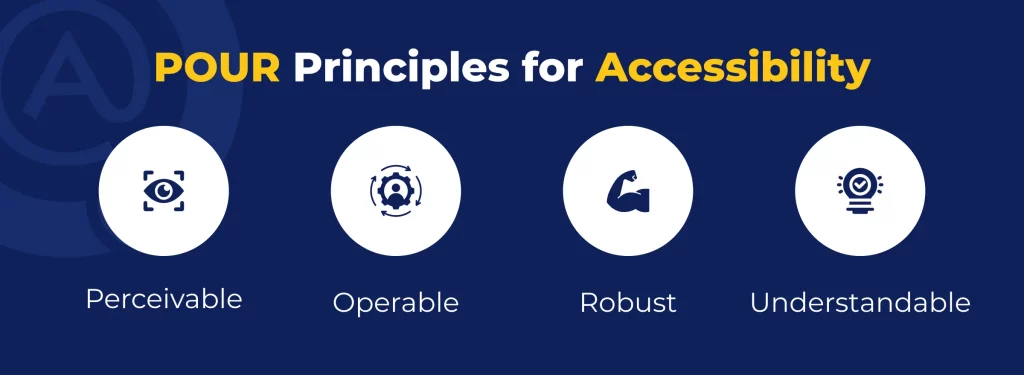European Accessibility Act: What It Means for Your Business and How to Get Ready
by Tetyana Lykhitska | April 3, 2025 2:47 pm
The European Accessibility Act (EAA) will officially come into force on 28 June 2025. It sets out clear accessibility requirements for a range of products and services, especially digital ones such as websites, mobile apps, and e-commerce platforms.
However, preparing for EAA compliance not only helps you avoid potential violations but also creates valuable opportunities. By improving the accessibility of your digital product, you can stay ahead of the competition, reach a broader audience, and strengthen your brand reputation. Therefore, instead of viewing accessibility as a challenge, embrace it as a way to grow and open new doors for your business.
This article will provide you with a clear understanding of the European Accessibility Act (EAA), its requirements, and how it impacts your digital products and services. By the end, you’ll be equipped with the knowledge to prepare your business for the EAA and take advantage of the opportunities it presents.
What is the European Accessibility Act?
The European Accessibility Act (EAA) is an EU directive that aims to improve accessibility for people with disabilities by setting common standards for products and services across Europe. Its main objective is to harmonize accessibility requirements across the EU, ensuring a more inclusive society and improving the single market for accessible products and services.
In the past, each EU member state had its own accessibility standards for products and services, leading to limited options, high prices for consumers, and fragmented markets. With the EAA, EU countries will now follow common accessibility rules, making it easier for businesses to offer compliant products and services across the EU. This will expand choices for consumers and create a more unified market.
With a compliance deadline of 28 June 2025, organizations covered by these requirements must prepare their products to meet the accessibility standards set out in the EAA by this date. Non-compliance could result in legal consequences, fines, and restricted market access, underscoring the importance of timely and thorough preparation.
If you’re not sure where to start, use our comprehensive guide[1] that outlines the key steps to preparing for an EAA compliance check.
Covered Products and Services
This regulation applies to businesses operating within the EU, as well as international companies offering digital content to EU consumers. It also covers businesses with more than 10 employees or an annual turnover exceeding €2 million.
The EAA covers a wide range of products and services, including:
- Computers and operating systems;
- ATMs, ticketing, and check-in machines;
- Smartphones;
- TV equipment related to digital television services;
- Telephony services and related equipment;
- Access to audio-visual media services such as television broadcasts and related consumer equipment;
- Services related to air, bus, rail, and waterborne passenger transport;
- Banking services;
- E-books;
- E-commerce.
There are a few specific exceptions to compliance:
- Pre-recorded time-based media (e.g., videos) published before June 2025
- Office file formats released before June 2025.
- Online maps, as long as essential information is provided in an accessible alternative.
- Third-party content that is not funded, developed, or controlled by the organization responsible for compliance.
- Archived content that will not be updated after June 2025.
What are the key dates for the EAA?
June 28, 2025: This is the critical deadline for all Member States to begin enforcing the EAA’s accessibility measures.
June 2030: By that time, services will have to remove inaccessible products that were introduced before June 28, 2025. Additionally, Member States will begin reporting on the implementation and impact of the Act.
To ensure your digital services are compliant in time, it’s essential to start preparing now. With our expertise, we can help you quickly identify accessibility gaps and compliance risks, enabling you to meet the requirements according to the deadlines – don’t wait until the last minute!
Benefits of EAA Compliance?

1. Traffic Increase
According to the World Health Organization (WHO) [1], around 1.3 billion people live with disabilities, making up 16% of the global population. In addition, a large senior demographic also faces impairments. By making your website accessible, you have the opportunity to engage this vast audience, turning them into loyal and regular customers. Not only will you increase traffic to your site, but you’ll also gain a competitive edge over businesses that haven’t yet taken steps to ensure accessibility.
2. Brand Reputation Strengthening
Brand marketing plays a crucial role in a business’s reputation. To maintain it, adapting to social trends, including accessibility, is vital for success. By making your product inclusive, you’ll not only align with current trends but also gain a competitive edge. This will help attract a broader audience, build customer loyalty, and ensure your brand remains in line with evolving expectations.
3. Better User Experience
When your website is accessible, its features become beneficial to everyone, not just users with disabilities. Options like contrast modes, font customization, spacing, and color adjustments can enhance the experience for various users, allowing them to personalize their browsing preferences. More importantly, users who rely on accessibility features will have an intuitive and enjoyable browsing experience that they wouldn’t otherwise have.
4. Long-term Success
In today’s world, acting with DEI (Diversity, Equity, and Inclusion) values is essential for businesses. By prioritizing these principles, companies not only contribute to a better society but also position themselves for long-term success. Ignoring DEI means missing out on a significant opportunity to foster inclusion and make a positive impact for future generations.
5. Better SEO Performance
One of the often-overlooked benefits of web accessibility is its positive impact on SEO. By incorporating elements like Alt Text, clear labels, dictionary definitions, and proper code modifications, your website can rank higher in search results on Google and other search engines. In essence, the more accessible your product is, the easier it becomes for search engine crawlers to index your content, boosting your visibility and driving more traffic to your site.
6. Compliance Readiness
Complying with accessibility guidelines now prepares your business for future regulations and avoids costly legal issues. Thus, familiarizing your team with accessibility today saves time and resources when the law is enforced in June.
What’s Required for EAA Compliance?
The EAA requires apps and websites to follow the accessibility principles POUR (Perceivable, Operable, Understandable, and Robust) in alignment with WCAG standards to ensure digital content is accessible to all users. Here is a short explanation of each requirement:
- Perceivable: Users with diverse disabilities should be able to perceive the presented information and user interfaces.
- Operable: Products and services must be designed to be operable by people with disabilities, such as those who have limited dexterity or who use assistive technology.
- Understandable: The information and operation of interfaces should be clear and understandable to all users.
- Robustness: Content must be robust enough to be interpreted reliably by a wide range of user agents, including assistive technologies.
You can use our checklist[2], which serves as a practical guide with the key steps needed to improve your product and prepare for EAA compliance.

How can QATestLab Help You Prepare for EAA Compliance?
Preparing for EAA compliance can be complex and time-consuming, but with QATestLab, you can streamline the process and make it significantly more efficient. Ensuring your product is accessible to all users becomes crucial for both legal compliance and creating a positive user experience. We specialize in identifying accessibility gaps and helping you make the necessary improvements to meet the required standards.
How we can help:
- Initial Assessment and Planning: We start our collaboration by discussing your accessibility requirements, estimating the resources needed to test your software, and providing a detailed test plan to guide the process.
- Automated and Manual Testing: We use a combination of automated tools and manual checks to give you a clear, reliable view of your product’s accessibility status and what needs to be improved.
- User-Centric Testing: Our QA specialists will verify both the usability and accessibility of your software by simulating real-life scenarios, ensuring your product meets the needs of all users.
- Assistive Technology Compatibility Testing: We test how your software interacts with assistive technologies like screen readers, magnifiers, and alternative input devices to ensure it is fully navigable by all users.
- Quick Results and Detailed Reporting: After testing, we provide comprehensive and transparent reports on identified accessibility issues, along with detailed test documentation, including the test plan, test scenarios, and/or test cases.
Final Words
Complying with the EAA goes beyond meeting regulatory requirements. It’s an opportunity to strengthen your market presence and build a more inclusive brand. Our experienced testers will help you identify accessibility gaps and potential compliance risks in your product, enabling you to make timely improvements and confidently meet upcoming requirements. Don’t wait until it’s too late – contact us[3] to test your platform’s accessibility now to stay ahead of EAA compliance!
 [4]
[4]Sources
- World Health Organization (WHO)[5]
Learn more from QATestLab
Related Posts:
- comprehensive guide: https://go.qatestlab.com/99
- checklist: https://go.qatestlab.com/92
- contact us: https://go.qatestlab.com/49
- [Image]: https://go.qatestlab.com/49
- World Health Organization (WHO): https://www.who.int/news-room/fact-sheets/detail/disability-and-health
- The Importance of Accessibility Testing in Meeting EAA Standards: https://blog.qatestlab.com/2025/07/17/the-importance-of-accessibility-testing-in-meeting-eaa-standards/
- Inside Shoptalk Europe 2025: Hunting Retail AI Insights : https://blog.qatestlab.com/2025/06/18/inside-shoptalk-europe-2025-hunting-retail-ai-insights/
- Is Your E-commerce Ready for Black Friday & Cyber Monday? Let’s Check!: https://blog.qatestlab.com/2024/11/12/is-your-e-commerce-ready-for-black-friday-and-cyber-monday/
Source URL: https://blog.qatestlab.com/2025/04/03/european-accessibility-act-what-it-means-for-your-business-and-how-to-get-ready/

